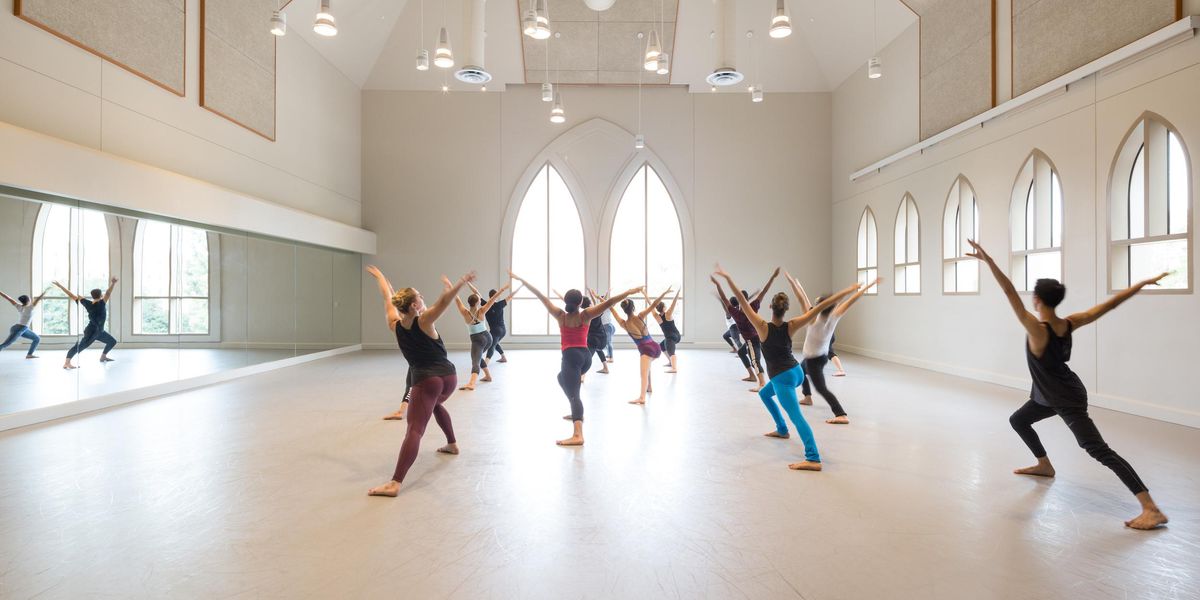Plugged In
Merce Cunningham iPad app, NDT in movie theaters, Where Snowflakes Dance and Swear, Martha Graham in Love and War, Screendance, Svetlana Lunkina in Giselle on DVD
iPAD APP
Always one to explore new technologies, Merce Cunningham now has an app that contains everything you’d want to know about his life and work—three years after he died. The interactive publication Merce Cunningham: 65 Years, created jointly by the Aperture Foundation and the Cunningham Dance Foundation, extends the contents of archivist David Vaughan’s stunning book, Merce Cunningham: Fifty Years. Cunningham’s astonishing essay “The Impermanent Art” alone is worth the money. Here’s just one of his pearls of wisdom. “Our ecstasy in dance comes from the possible gift of freedom, the exhilarating moment that this exposing of the bare energy can give us. What is meant is not license, but freedom, that is a complete awareness of the world and at the same time a detachment from it.”
The Cunningham company in
Beacon Events (2007–2009), from the interactive publication Merce Cunningham: 65 Years. Photo by Stephanie Berger, Courtesy Aperture.
The updated digital version brings Cunningham’s story and legacy up to the completion of the company’s Legacy Tour last year. With 40 video excerpts of performances, enlargeable photos—including Cunningham’s deliciously whimsical drawings of animals—and snippets of journals, this app puts a semester’s worth of dance history at your fingertips. In the chronology you learn that he was making dances for at least 20 years before gaining recognition. In the video clips, you can see Merce lifting the celestial Carolyn Brown in a sustained float in Septet, or the eerie mix of dancers and motion-capture figures in BIPED, or the humorous partnering of Pond Way. Relaxed interviews between Cunningham and Vaughan make you feel like you are in the room with them. All together, one gleans the “ordinary” in his aesthetic—he speaks of taxi cabs or of a woman crossing the street wearing a backpack and holding a baby—but also how he transformed the ordinary into the extraordinary. $14.99. —Wendy Perron
CINEMA
The adventurous dancers of Nederlands Dans Theater light up movie house screens across the country Nov. 25 and 27, thanks to Ballet in Cinema’s featuring the company in its series of cinemacasts this season. The bill includes two pieces by maestro Jirí Kylián—celebrated for the way he shades sweeping phrases with pedestrian touches, or sends simple movements surging into a dramatic storm of steps—and works by Johan Inger and Medhi Walerski, choreographers who were nurtured at NDT. The program reflects the company’s philosophy, post-Kylián, to both honor the choreographer who remains so closely identified with the company, yet also show that his legacy lives in the next generation of dancemakers. See www.balletincinema.com to find a theater near you. —Kina Poon
Jorge Nozal of NDT. Photo by Rahi Rezvani, Courtesy NDT.
BOOKS
Where Snowflakes Dance and Swear: Inside the Land of Ballet
By Stephen Manes
New York. Published by Cadwallader and Stern. 910 pages. Illustrated. Hardcover: $35. Paper: $24.99.
Reality TV may have taken an interest in ballet recently, but for a behind-the-scenes look at the life of a company, Stephen Manes’ Where Snowflakes Dance and Swear is set to become the gold standard. Manes, a longtime journalist, was granted unprecedented access to Pacific Northwest Ballet during the 2007-–2008 season, and his mammoth volume, out in paperback this month, takes in every aspect of the art form, from company and school rehearsals to board meetings and technical issues. Each chapter weaves together minutiae from the daily goings-on in the studio with interviews and portraits. While the amount of information is frequently overwhelming, it answers in great detail that common question: What really goes into getting a ballet onstage?
Newcomers will appreciate this introduction to the “Land of Ballet,” and Manes is particularly insightful when it comes to the role of stagers, the balance of power under director Peter Boal, and the company premiere of Jean-Christophe Maillot’s Roméo et Juliette. A rich, pragmatic resource to dip in and out of. —Laura Cappelle
Martha Graham in Love and War: The Life in the Work
By Mark Franko
Published by Oxford University Press. 231 pages. Illustrated. Hardcover: $29.95.
Mark Franko’s new book describes how Graham’s early works were influenced by both her tumultuous personal life and the culture of America at the time. It was during these years—before, during, and in wake of World War II—that she met, fell in love with, married, and divorced Erick Hawkins.
Franko is a thorough researcher (as you’ll notice from the 37 pages of footnotes and 9-page bibliography), and he uses the information on Graham’s politics, rise to fame, and her relationship with Hawkins to provide keen insight into both her choreographic masterpieces and lesser-known works.
In the first half, Franko explores why Graham chose an anti-Fascist position through Americana-themed work before diving deep into Greek mythology.
Throughout the book Franko has uncovered some real gems. Graham’s correspondence reveals a vulnerable, lovesick, and remorseful side of her that has rarely been publicized. The usual portrayal of Hawkins as fame-hungry and solely self-interested is also examined anew, as Graham blames herself for the collapse of their romance. “Why did I do what I did to destroy or corrupt our relationship?” she wrote in a letter to Hawkins.
Graham and Hawkins in her
American Document (1938). Photo from The Music Division, Library of Congress, Courtesy OUP.
Franko’s writing style can be dense and academic, keeping the reader at a distance from the personal love story that was evolving and deteriorating during this segment of Graham’s career. But the love story is not Franko’s immediate focus. He seeks instead to analyze its impact on classic works like American Document, Appalachian Spring, and Night Journey. (He also devotes a chapter to the minor work Voyage, whose purpose, it seems, was “to come to terms with the separation from Hawkins.”)
These works remind us that a broken heart can provide fodder for the creative process. “The loss of Hawkins was a momentous event that Graham in most likelihood never fully recovered from,” he writes. “But it also occasioned an immensely courageous will to radically alter her concept of choreography.” —Emily Macel Theys
Screendance: Inscribing the Ephemeral Image
By Douglas Rosenberg
Published by Oxford University Press. 232 pages. Illustrated. Paper: $29.95.
Douglas Rosenberg teaches interdisciplinary courses at the University of Wisconsin—Madison and curates the International Screendance Festival at the American Dance Festival; he’s been engaged with video and dance for close to 30 years. In 10 closely argued chapters, he asserts that dance for camera, stuck in a protracted adolescence, suffers from a lack of “criticality,” that its practitioners need to do more theoretical thinking and writing if the field is to be taken seriously. He discusses the difference between “curation” and “programming,” and observes that “screendance has yet to be fully interrogated either within the university environment or in the context of contemporary art, and the literature framing screendance as a practice has not so far achieved a critical mass.”
Rosenberg’s accomplishment is an essential one, but actually getting through his book requires at least a master’s degree in performance studies or a serious passion for the history, theory, art, and craft of melding dance with durable electric and electronic media. Don’t say I didn’t warn you. —Elizabeth Zimmer
DVD
Giselle: The Bolshoi Ballet
Bel Air Classiques. $29.99. 109 minutes.
In 1997, a teenaged Svetlana Lunkina, straight out of the Moscow Choreographic Academy, stepped into the lead role of Vladimir Vasiliev’s Giselle. The youngest dancer in the Bolshoi Ballet’s history to perform the doomed heroine, she received raves for her delicate, fresh interpretation. Now, 15 years later, her Giselle (albeit in Yuri Grigorivich’s production) has been captured on DVD—and it remains a treasure. Her elegant port de bras and swan-necked grace make the second act a dream. She brings intelligence and experience to her every movement. Lunkina is complemented by a solid performance from Dmitry Gudanov as Albrecht, and an imposing Myrtha from Maria Allash. One distraction: some missing mime and changes in sequence (for example, the peasant pas is not performed in the presence of Bathilde and the rest of the nobility) undercut the drama of the story. —K. P.
Svetlana Lunkina and Dmitry Gudanov. Photo by M. Logvinov, Courtesy Naxos.





